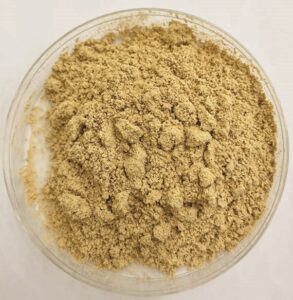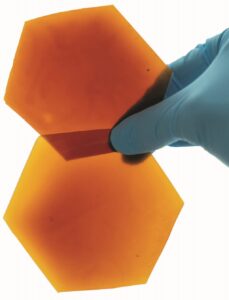Stronger canola plastics, enhanced canola fibre and more
How does research pay?
Doug Heath, research manager with SaskCanola, provided some napkin math to show the low cost of research and potential high return to farmers on a per-farmer per-project basis.

SaskCanola’s levy is 75¢ per tonne of delivered canola seed. A farmer who plants 5,000 acres of canola and achieves yields of one tonne per acre (44 bu./ac.) would pay $3,750 annually to SaskCanola. Total revenue to the farm for that canola is $3.5 million, based on $700 per tonne selling price.
SaskCanola funds dozens of research projects per year, including pre-breeding germplasm development research to find disease resistance genes and other traits. The average germplasm development project costs SaskCanola about $100,000 per year. This is 1.25 per cent of SaskCanola’s annual budget of around $8 million. For the farmer above, 1.25 per cent of their $3,750 annual levy is $47. If the project takes three years, the farmer invests $141 in a project that could ultimately lead to a new disease resistance trait. If that trait provides as little as a one per cent yield gain, the annual return on investment would be $35,000 on the farmer’s 5,000 canola acres.
“Pre-breeding genetics research helps drive the whole seed breeding industry forward at minimal cost to farmers,” Heath concludes.
The new Sustainable Canadian Agriculture Partnership makes return on investment calculations a mandatory activity for research funding. Curtis Rempel, Vice President, Crop Production and innovation with the Canola Council of Canada, says the return on investment calculation is based on probability of success divided by time. Probability of success has two components: What is the likelihood that a research project will provide a valuable best management practice (technical success) or valuable new product (commercial success)? And how many years will the research take?
“We’re still considering how many farms or how many acres need to adopt a practice or product for it to be considered a success,” Rempel says. “Overall, we want to apply a more disciplined approach to value chain decisions on which research projects to fund.”
Why does canola carbon intensity matter?
Bob Laroque began his presentation naming two things he wanted everyone to remember: “We love canola and we’re going to need a lot more of it” and “Remember carbon intensity, because that’s the game changer.” Larocque is president and CEO of the Canadian Fuels Association. Larocque says biodiesel will be replaced, for the most part, by renewable diesel. Renewable diesel is made from hydrotreating vegetable oils or animal fats, and is fully compatible with diesel engines. A tractor can burn 100 per cent renewable diesel.
“Remember carbon intensity, because that’s the game changer.”
– Bob Larocque
Dozens of renewable processing facilities are on stream or announced across North America, mostly in the United States. Tidewater in B.C. is the first renewable diesel processor in Canada, starting production in October 2023. Larocque expects demand for renewable diesel feedstock will increase tenfold by 2030. Canola is currently the top feedstock in Canada. One facility can produce one billion litres of renewable diesel per year. It would take about 2.5 million tonnes of canola seed to supply that one plant, assuming that plant relied entirely on canola as a feedstock. “This isn’t likely,” Vervaet says, “but with canola readily available in our backyard, it’s safe to assume the plants in Canada will be looking to source low carbon canola for their operations.” Canada’s total canola production in 2023 was around 18 million tonnes.
Carbon intensity. Clean Fuel Regulations and biofuel rules in B.C. and California include carbon intensity standards. The lower the carbon intensity of a feedstock, the less of it a facility needs to blend to reach the carbon reduction standards. Canola oil has a higher carbon intensity than other sources, including used cooking oil and animal fat, which makes canola oil a more expensive feedstock option. Canola oil has good supply, which helps, but lower carbon intensity would strengthen its appeal. “There is always room for continuous improvement and I think that is something we’re committed to doing as an industry,” says Chris Vervaet, executive director of the Canadian Oilseed Processors Association.
Carbon intensity is net emissions divided by tonnes of crop produced. Over half of canola’s carbon footprint comes in the production phase, and fertilizer accounts for most of the carbon-equivalent emissions in this phase. Largest shares of fertilizer emission comes in nitrogen fertilizer manufacturing and in nitrous oxide emissions at the field level. Canola can improve its carbon intensity score by reducing nitrous oxide emissions and by increasing nitrogen use efficiency – more production from the same amount of fertilizer. Anything farmers and researchers do to increase yield should help, Vervaet says. More yield also means more supply, which is essential to sector growth.
Fibre is bad for animals? Not necessarily
Anna Rogiewicz, nutritional biochemist at the University of Manitoba, demonstrated the potential of canola meal fibre in poultry nutrition. Previous work by fellow University of Manitoba researcher Bogdan Slominski showed that canola meal could be fed to poultry at inclusion rates of 15 to 20 per cent with no loss in performance compared to soybean meal. U of M researchers, including Rogiewicz and Slominski, took the research a step further, exploring options to make better use of the large fibre components of canola meal.

“In animal nutrition, when something goes wrong with canola meal in diets, people say it’s because of the fibre,” Rogiewicz says. But fibre isn’t necessarily bad. We just need to understand it better, she says.
Canola meal is 35 to 40 per cent fibre. The largest fibre components are non-starch polysaccharides, which have “great prebiotic potential,” Rogiewica says. Next are lignins and polyphenols, which have low nutritional value for animals. And finally, glycoproteins, the “ugly” fractions of fibre that result from the heating step in canola processing. Excess heat creates these glycoprotein pieces that bind with the amino acid lysine, making the lysine unavailable to animals. The good news, Rogiewicz says, is that processors have made big improvements to reduce the heat damage, improving the protein availability for animals.

Rogiewicz’s research is treating canola meal with enzymes to enhance the fibre components. With these treatments, total dietary fibre goes way down as the non-starch polysaccharides are partially hydrolyzed into bioactive components, crude protein goes up and, due to the spontaneous fermentation during the processing, pH goes down. Lower pH is good for animal feed. The fibre components of this treated meal exert the probiotic effect that improves gut health and good biota, and that substantially reduces pathogenic bacteria such as E. coli and Salmonella. This could achieve the same objective as growth-promoting antibiotic use without the need for antibiotics, Rogiewicz says. These enhanced canola meals also show good results in weaned piglet diets.
How to improve canola-based food packaging?

Food packaging uses 78 million tonnes of plastic annually, and only 14 per cent is recycled, says Nandika Bandara, a researcher at the University of Manitoba. Countries are also looking at bans on single-use plastics. Food packaging presents a large market potential for biodegradable plant-based plastics and polymers. However, biopolymers have limitations compared to fossil fuel-based plastics: biopolymers have low or less consistent tensile strength, higher water permeability, higher oxygen permeability and lower thermal stability. In short, they are weaker and let too much water and oxygen pass through the package for safe long-term storage.
Bandara’s lab has tried various methods to improve polymers derived from canola protein. Adding five per cent oxidized nanocrystalline cellulose, which is commercially available from Innotech Alberta, doubled the tensile strength versus the control. The control is a canola meal polymer without the five per cent nanocrystalline cellulose. Nanocrystalline cellulose also increased thermal stability, which is tolerance to heating, important in a microwave. But this didn’t improve water permeability. However, adding nanocrystalline cellulose-oleic acid conjugates, also in small amounts, greatly reduced water permeability. Finally, adding graphite oxide showed a sixfold reduction in oxygen permeability. Bandara’s work moves us toward a canola-based biopolymer with functionality closer to fossil fuel-based products.
How are RNAi insecticides better for biodiversity?
Jeff Bertholet, who recently joined Greenlight BioSciences after a long career with BASF, spoke at Canola Week about a new RNAi-based insecticide called Calantha. At the time of his presentation, Greenlight was seeking – but did not have – approval from the U.S. Environmental Protection Agency for use on Colorado potato beetle. Approval from the EPA and several potato-growing states came in early January, and Calantha will be available to growers in the United States for use on potatoes in the upcoming crop year.
Deoxyribonucleic acid (DNA) is the genetic code for growth and function of an organism. Ribonucleic acid (RNA) grabs sections of code to deliver specific messages to target areas within the organism. By chemically interfering with these messages, RNA interference (RNAi) active ingredients can stop critical growth and function pathways within the target pest. Through a process of double-stranding, chemists make the RNAi molecules much more stable and suitable for commercial storage, packing and application.
In its media release, Greenlight wrote that “consumption of the dsRNA (double-stranded ribonucleic acid) by the Colorado potato beetle – and only the beetle – causes it to stop eating and die from its own toxins. Even when tested at 100 times the rate that it will be used in agricultural fields, it has no effect on tested species other than the Colorado potato beetle.” This specificity is a key benefit of RNAi-based pesticides.
Calantha, Greenlight says, also degrades within three days “leaving no harmful residue on plants or in the environment, soil or waterways,” works with regular sprayer tools, and provides farmers with an alternative mode of action. The active ingredient, ledprona, is designated as a Group 35 insecticide.
Calantha is the first registration in the United States of a foliar-applied product with an RNA ingredient. Greenlight says its next RNAi solution targets varroa mites, a pest of honeybees, and was submitted to the EPA for regulatory review in early 2023.
How does the CFIA support gene editing?
New guidance from the Canadian Food Inspection Agency (CFIA) makes it easier to bring gene-edited cultivars into commercial production. The government’s list of new “non-novel products of plant breeding” includes a potato cultivar from Simplot. Breeders used CRISPR-Cas9 to reduce expression of a gene that limited tuber set. The cultivar will therefore produce more tubers. Another company, Pairwise Plant Services, used CRISPR-Cas12a to reduce expression of genes that conferred pungency in Brassica juncea mustard greens, a leafy green used in salads. The gene-edited greens are less spicy.
Heather Shearer, policy and programs manager with the Canadian Food Inspection Agency, described in a Canola Week presentation the new guidance, published in May 2023, that supports the introduction of these and other gene-edited products in the Canadian market. With gene editing, canola breeders can amplify genes or turn off genes as needed to, for example, make the crop more resilient to pests and climate, and improve yields.
In its guidance document, the CFIA writes: “It is the scientific opinion of the CFIA that gene editing technologies do not present any unique or specifically identifiable environmental or human health safety concerns as compared to other technologies of plant development.”
CFIA notes that cultivars with a herbicide resistance trait or foreign DNA still fall under the “plants with novel traits” (PNT) regulations. “Breeders are expected to be certain that there is no foreign DNA in any product that is commercialized or field-tested, and should fully participate in transparency mechanisms,” Shearer says.
Chad Koscielny, North American canola breeding lead at Corteva Agriscience, says the new CFIA guidance “will help us continue to investigate gene-edited solutions for canola growers and do so more easily and efficiently.”
However, he adds, commercial launch of gene-edited cultivars will depend on regulations in export markets. “Therefore, this doesn’t allow us to deliver gene-edited product to farmers right away,” Koscielny says. “We appreciate that the Canadian government is moving this direction. It illustrates it can be done. We can be an example to the rest of the world.”
Dave Kelner, North America canola portfolio manager for Bayer, says, “The new CFIA guidance should inspire Bayer canola advancements since all breeding technologies, including the use of multiple genome edits, can be efficiently tested in Canada without the additional isolation, inspection and post-harvest monitoring resources needed for PNTs. Given the guidance on gene editing in Canada, we’re cautiously optimistic on the path forward as we await other export markets to complete their assessments.” Bayer has very early, proof of concept gene-edited efforts within its canola pipeline and will begin field testing them in 2024.
The Canola Week 2023 playlist, when available will be featured here.
Why could grasshoppers be worse in 2024?
Meghan Vankosky, research scientist and insect specialist with Agriculture and Agri-Food Canada in Saskatoon, provided a pest insect year in review. Her presentation included a photo of 1,788 grasshoppers captured in 25 sweeps in a ditch near Kindersley, Saskatchewan in June 2023. Vankosky credited her summer student Taylor Dzikowski for doing the counting. It was a bad year for grasshoppers, Vankosky says, and 2024 could be worse.
 “Grasshopper densities in late summer and early fall of one year are indicative of the potential for grasshopper risk in the following season, assuming that weather conditions remain favourable,” Vankosky says. “Areas with high grasshopper densities in 2023 are at high risk in 2024, unless spring weather is cool and wet.”
“Grasshopper densities in late summer and early fall of one year are indicative of the potential for grasshopper risk in the following season, assuming that weather conditions remain favourable,” Vankosky says. “Areas with high grasshopper densities in 2023 are at high risk in 2024, unless spring weather is cool and wet.”
In warm, dry years, grasshopper eggs develop quickly in the spring and nymphs mature quickly to adulthood. This scenario created a large and early population of hungry adults in 2023. Prairie Pest Monitoring Network has a grasshopper distribution map for 2023, which growers and agronomists can use to forecast risk areas for 2024. Find the map at prairiepest.ca.





